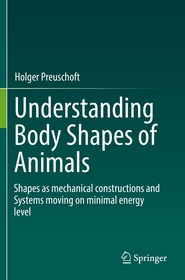
Understanding Body Shapes of Animals
Shapes as mechanical constructions and Systems moving on minimal energy level
- Publisher's listprice EUR 192.59
-
79 876 Ft (76 073 Ft + 5% VAT)
The price is estimated because at the time of ordering we do not know what conversion rates will apply to HUF / product currency when the book arrives. In case HUF is weaker, the price increases slightly, in case HUF is stronger, the price goes lower slightly.
- Discount 12% (cc. 9 585 Ft off)
- Discounted price 70 291 Ft (66 944 Ft + 5% VAT)
Subcribe now and take benefit of a favourable price.
Subscribe
79 876 Ft

Availability
printed on demand
Why don't you give exact delivery time?
Delivery time is estimated on our previous experiences. We give estimations only, because we order from outside Hungary, and the delivery time mainly depends on how quickly the publisher supplies the book. Faster or slower deliveries both happen, but we do our best to supply as quickly as possible.
Product details:
- Edition number 1st ed. 2022
- Publisher Springer International Publishing
- Date of Publication 17 July 2025
- Number of Volumes 1 pieces, Book
- ISBN 9783030276706
- Binding Paperback
- See also 9783030276676
- No. of pages581 pages
- Size 235x155 mm
- Language English
- Illustrations XIV, 581 p. 222 illus. Illustrations, black & white 679
Categories
Long description:
"
This book discusses how and why animals evolved into particular shapes. The book identifies the physical laws which decide over the evolutionary (selective) value of body shape and morphological characters. Comparing the mechanical necessities with morphological details, the author attempts to understand how evolution works, and which sorts of limitations are set by selection.
The book explains morphological traits in more biomechanical detail without getting lost in physics, or in methods. Most emphasis is placed on the proximate question, namely the identification of the mechanical stresses which must be sustained by the respective body parts, when they move the body or its parts against resistance.
In the first part of the book the focus is on ‘primitive’ animals and later on the emphasis shifts to highly specialized mammals. Readers will learn more about living and fossil animals.A section of the book is dedicated to human evolution but not to produce anotherevolutionary tree, nor to refine a former one, but to contribute to answering the question: “WHY early humans have developed their particular body shape"".
Table of Contents:
Chapter1: Why this book?.- Chapter2: Head.- Chapter3: Axial skeleton in aquatic animals.- Chapter4: Axial skeleton and muscle arrangement in terrestrial tetrapods.- Chapter5: What have the extremities of “lower tetrapods” in common? And Why?.- Chapter6: Birds.- Chapter7: Land-living mammals.- Chapter8: Primates, the group including humans.- Chapter9: Evolution of hominids.- Chapter10: Summary, Conclusions and Open questions.
More





